RFID Journal LIVE! 2023 will feature end-user companies discussing RFID’s use in various industries, as well as exhibitors offering tagging solutions for multiple applications. To learn more, visit the event’s website.
- NXP Adds NFC to Secure Element for Matter Devices
- STAR Systems Receives Patent for Antenna Design
- TSC Printronix Print Engine Offers RFID Encoding
- Sierra Wireless Unveils IoT Module with Sony Chipset
- Renesas, AMD Collaborate on RF Front-End Solution
- ScaleOut Software Adds Simulation to Digital Twin Service
- Industry IoT Consortium Publishes New White Paper
- KnarrTek White Papers Discuss ERP, RFID Data Capture
Presented here are recent news announcements in the radio frequency identification and Internet of Things industries.
NXP Adds NFC to Secure Element for Matter Devices
NXP Semiconductors has announced the EdgeLock SE051H, a secure element designed for Matter devices. The single-chip solution, the company reports, comes with integrated Near Field Communication (NFC) technology to simplify the onboarding of Matter devices and enable smart-home user experiences. It provides suggested automations, installation videos and other content with the tap of an NFC-enabled phone.

The Matter standard, designed by the Connectivity Standards Alliance (CSA), is intended to ease device interoperability challenges within smart-home networks. It increases security with features to protect smart-home devices, including cryptographic keypairs, digital certificates, and other security-related hardware and firmware requirements. The EdgeLock SE051H supports these requirements, according to the company, including the algorithms and cryptographic functions needed for Matter, enabling device manufacturers to incorporate security protections into end devices.
“The Matter standard was designed with security in mind, recognizing that security is an essential component to the future of the smart home,” said Philippe Dubois, NXP’s senior VP and general manager for secure transactions and identification, in a prepared statement. “The single-chip EdgeLock SE051H makes it easy for developers to secure their Matter-certified smart-home devices, while integrated NFC improves the end-user Matter experience and allows device makers to differentiate based on that user experience.”
The EdgeLock SE051H is Common Criteria EAL 6+ certified, NXP reports, and supports the cryptographic operations needed for a Matter-certified smart device. This includes Matter device attestation and certificate-based authentication with ECC cryptography and NIST P-256 curve, as well as the SPAKE2+ algorithm for password authenticated key exchange. It includes key security functions such as ECDSA, ECDH and True Random Number Generator to protect the Matter protocol, and it has an integrated NFC interface and Type-4 Tag capability.
STAR Systems Receives Patent for Antenna Design
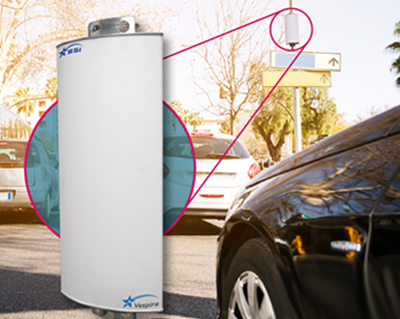 STAR Systems International (SSI), a provider of smart-city products, has announced that patents have been granted for the company’s Vespira antenna. The antenna is designed to be a curb-side antenna for smart-city initiatives, SSI explains, such as congestion pricing and traffic monitoring. SSI’s patented antenna design provides an electronically down-tilted radiation pattern in a curved structure. This, the company explains, allows the Vespira to be mounted upright and flush to a utility pole, creating a read zone while blending in with urban environments.
STAR Systems International (SSI), a provider of smart-city products, has announced that patents have been granted for the company’s Vespira antenna. The antenna is designed to be a curb-side antenna for smart-city initiatives, SSI explains, such as congestion pricing and traffic monitoring. SSI’s patented antenna design provides an electronically down-tilted radiation pattern in a curved structure. This, the company explains, allows the Vespira to be mounted upright and flush to a utility pole, creating a read zone while blending in with urban environments.
Awarded by the U.S. Patent and Trademark Office and the Taiwan Intellectual Property Office, the patents are expected to remain in force for 20 years. “We are very happy to receive these patents,” said Stephen Lockhart, SSI’s CTO and a co-inventor of the new design, in a prepared statement. “Vespira is an excellent product for urban congestion pricing.” Lockhart said the patent “endorse SSI’s strategy to stay at the forefront of technological development and our commitment to transforming the automatic vehicle identification industry.”
TSC Printronix Print Engine Offers RFID Encoding
TSC Printronix Auto ID has announced that it has launched its 6-inch PEX-2000 print engine, which allows automatic labeling companies to configure preferences for speed, accuracy and synchronization. The PEX-2000’s compatible hardware and software enables it to be integrated into any print and apply system, TSC reports, and the device supports DB15 and DB25 interfaces and major printer brands’ GPIO emulations. Customizable firmware supports major printer languages, so template commands and print files can remain the same.
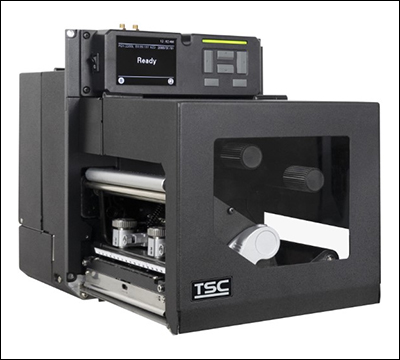 According to TSC, the PEX-2000 is suitable for use in compact spaces. Its metal chassis is built to withstand harsh environments and demanding 24-7 operation, and a magnetic lock ensures the media door remains firmly shut in any orientation. A 55-millimeter (2.2-inch) aperture is designed to simplify media handling and parts changes. Printheads can be removed and replaced within seconds, TSC notes, while the rear chassis can be lifted and pulled out quickly, allowing maneuverability for repairs, maintenance or component replacement.
According to TSC, the PEX-2000 is suitable for use in compact spaces. Its metal chassis is built to withstand harsh environments and demanding 24-7 operation, and a magnetic lock ensures the media door remains firmly shut in any orientation. A 55-millimeter (2.2-inch) aperture is designed to simplify media handling and parts changes. Printheads can be removed and replaced within seconds, TSC notes, while the rear chassis can be lifted and pulled out quickly, allowing maneuverability for repairs, maintenance or component replacement.
“We considered everything while developing the PEX-2000: maximizing uptime, combating space constraints and improving users’ daily operations,” said Victoria Grobushkina, TSC Printronix Auto ID’s EMEA sales director, in a prepared director. “Its advanced performance is suited to diverse applications, including optional RFID encoding and top black-mark sensors to support pre-printed labels.”
An adjustable module allows labels to be peeled off in angles ranging from -18 degrees to -3 degrees, without the need to redesign peelers or application arms, TSC reports. The PEX-2000 is available in 203 or 300 dpi print options, with a top speed of 14 and 12 inches per second, respectively. The print engine can be remotely configured, updated, monitored and troubleshot through TSC Console or SOTI Connect software tools. Printhead health status can be monitored in real time, reducing the risk of downtime and preventing bad-quality barcodes from entering supply chains.
Sierra Wireless Unveils IoT Module with Sony Chipset
Semtech subsidiary Sierra Wireless, an Internet of Things (IoT) solutions provider, has announced its latest HL Series low-power wide-area (LPWA) module, known as the 5G HL7900, for use cases requiring ultra-low power, device longevity and support for 3GPP‘s latest 5G standards. The module incorporates the ALT1350 chipset from Sony Semiconductor Israel (Sony), which enables unlicensed spectrum communications protocols and satellite connectivity.
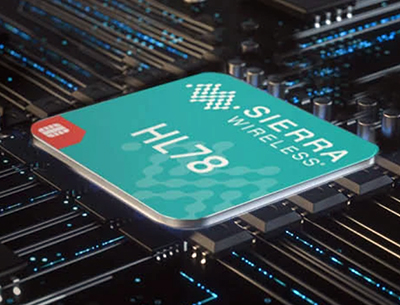 “Not only does Sony’s Altair ALT1350 chipset enable hybrid connectivity options, but its advanced architecture sets a new bar in ultra-low power consumption,” said Dima Feldman, Sony Semiconductor Israel’s VP of product management and marketing, in a prepared statement. “Its optimized standby mode (eDRX) reduces power consumption by 80 percent when compared to the current generation, with battery-operated devices benefitting from four times’ longer battery life for typical use cases.”
“Not only does Sony’s Altair ALT1350 chipset enable hybrid connectivity options, but its advanced architecture sets a new bar in ultra-low power consumption,” said Dima Feldman, Sony Semiconductor Israel’s VP of product management and marketing, in a prepared statement. “Its optimized standby mode (eDRX) reduces power consumption by 80 percent when compared to the current generation, with battery-operated devices benefitting from four times’ longer battery life for typical use cases.”
The HL7900 with ALT1350 chipset offers a long battery life and enhanced security, the company reports, while integrated sub-GHz and 2.4 GHz radios enable low-power IoT protocols, offering customers the flexibility of multiple connectivity options. The module will support 3GPP’s latest releases—15, 16 and 17 for LTE-M/NB-IoT—enabling it to accommodate evolving network configurations and new features.
“The new 5G LPWA HL7900 not only provides ultra-low power and network future proofing, but it also enables next-generation use cases with its integrated low-power MCU for customer hosted edge applications, and the ability to enable hybrid connectivity with multiple protocols supported on one SKU,” added Tom Mueller, the EVP of Semtech’s IoT System Products Group, in the statement.
Renesas, AMD Collaborate on RF Front-End Solution
Renesas Electronics, a supplier of semiconductor solutions, has announced its RF front-end solution for 5G active antenna system (AAS) radios, created in collaboration with AMD. Paired with AMD’s Zynq UltraScale+ RFSoC Digital Front End Open Radio Access Network (OpenRAN) reference design, the system includes RF switches, low-noise amplifiers and pre-drivers, and is designed to meet the demand of the mobile network infrastructure market.
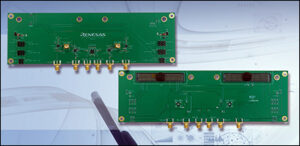
The 5G design platform integrates the RF and digital front-end hardware required for base stations operating in the OpenRAN ecosystem. This includes a high-isolation multi-throw digital pre-distortion (DPD) switch, a high-gain and linearity pre-driver, and an integrated switch and low-noise amplifier with input signal coupling functionality. The RF front-end platform is designed to process and transmit data to wireless networks, according to Renesas, and it has been integrated with the RFSoC DFE ZCU670 Evaluation Kit for prototyping and development of wireless network systems.
The platform minimizes DPD resources for TX channel linearization, the company explains, improving radio efficiency and reducing operating costs for wireless network providers. Renesas and AMD previously collaborated on an RF timing solution for 5G Next-Gen Radio that incorporates Renesas’s IEEE 1588-enabled System Synchronizer as part of the DFE ZCU670 Evaluation Kit.
“We are thrilled to be collaborating with AMD once again to demonstrate our latest RF capabilities,” said Naveen Yanduru, the VP of RF engineering in Renesas’s Infrastructure Business Division, in a prepared statement. “Using our turnkey hardware solution, developers of 5G RF wireless infrastructure systems can reduce development time and cost. We are confident that this solution will set a new standard in RF performance and efficiency for the wireless communication market.”
ScaleOut Software Adds Simulation to Digital Twin Service
ScaleOut Software has announced new device modeling and simulation capabilities for its Digital Twin Streaming Service, extending its ability to perform real-time analytics at scale using digital twins to track devices and other real-world data sources. Users can simulate data-source behaviors using digital twins prior to deployment, as a tool for evaluating design choices and improving decision making. This offers benefits to data analysts and managers in a range of industries, the company reports, including telematics, logistics, security, healthcare, crime prevention and financial services.
Beyond product lifecycle management, ScaleOut indicates, the simulation capabilities using digital twins can assist in developing real-time analytics applications. The streaming service enables digital twins to generate and analyze telemetry. For example, developers can model a fleet of trucks with digital twins that send telemetry to additional digital twins, which implement real-time analytics for tracking the fleet, identifying any issues and evaluating performance. The service can record telemetry from live devices and replay it in simulation to assist in performing offline analytics.
 “We are excited to extend the capabilities of our streaming service to harness digital twins for both simulation and real-time analytics,” said William Bain, ScaleOut Software’s CEO and founder, in a prepared statement. “By hosting digital twins using our highly scalable, in-memory computing technology, we enable our customers to simulate large systems with complex interactions and gain insights not previously possible.”
“We are excited to extend the capabilities of our streaming service to harness digital twins for both simulation and real-time analytics,” said William Bain, ScaleOut Software’s CEO and founder, in a prepared statement. “By hosting digital twins using our highly scalable, in-memory computing technology, we enable our customers to simulate large systems with complex interactions and gain insights not previously possible.”
Managers can use the simulation capabilities to model thousands of interacting data sources and predict likely outcomes. For example, they can model the effect of delays for an airline’s flight schedule within a multi-hour, forward-looking window to predict and mitigate impacts on passengers caused by weather and equipment issues. This predictive capability, ScaleOut says, can assist in decision making during real-time operations.
Developers can construct simulations that model thousands of devices and other data sources, ScaleOut reports, while in-memory computing ensures high throughput and scaling during simulations with built-in high availability. Developers can harness the digital twin model to describe physical entities using an object-oriented representation of each device or data source, and the company’s Digital Twin Builder Toolkit lets developers construct models in Java and C#.
The Digital Twin Streaming Service helps managers analyze telemetry from real-world data sources and model those sources, thus simplifying the creation of workload generators for evaluating real-time analytics. The platform allows a single digital twin instance to simulate a data source’s behavior and analyze its telemetry. The service can capture telemetry from live data sources and replay it in simulation, to streamline workload generation for simulations and enable offline analysis. In addition, it can configure simulations to run faster than real time, enabling users to predict future events based on parameterizable scenarios.
Industry IoT Consortium Publishes New White Paper
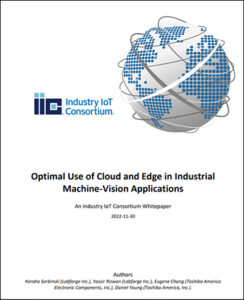 The Industry IoT Consortium (IIC) has published a white paper titled “Optimal Use of Cloud and Edge in Industrial Machine-Vision Applications.” According to the organization, the document is a brief guide for developers looking to integrate machine vision with industrial cloud and edge-computing applications.
The Industry IoT Consortium (IIC) has published a white paper titled “Optimal Use of Cloud and Edge in Industrial Machine-Vision Applications.” According to the organization, the document is a brief guide for developers looking to integrate machine vision with industrial cloud and edge-computing applications.
“With advances in technology, industrial machine vision is becoming increasingly sophisticated,” said Daniel Young, the IIC Technology Working Group’s co-chair and a senior manager at Toshiba, in a prepared statement. “For example, today you can perform AI vision analysis directly on a camera. You can also process this data on a nearby computer, an on-premises server or remote data center. Understanding where image processing should occur is an engineering decision based on many different factors. For example, cloud computing offers industrial applications flexibility and scalability for machine learning models, while edge computing is best for real-time industrial tasks.”
The white paper covers numerous topics. “Applications of Industrial Machine Vision” offers a broad description of how companies use industrial machine vision. “Edge Computing in Industrial Machine Vision” provides an overview of applying edge computing to industrial machine vision applications. “Cloud Computing in Industrial Machine Vision” discusses cloud computing in industrial machine vision. And “Deciding Where the Edge Lies in Industrial Machine Vision” explores typical edge-computing configurations that incorporate industrial machine vision.
KnarrTek White Papers Discuss ERP, RFID Data Capture
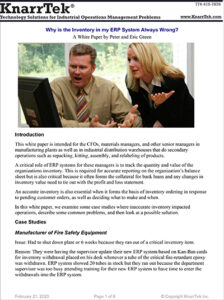 In a recent white paper from KnarrTek titled “From the Cloud to the Edge for Barcode and RFID Data Capture,” Peter Green traces the evolution of the BellHawk barcode and RFID job and materials-tracking system. Green recounts the system’s development from its early days, using a client-server architecture, to running at a remote data center in the cloud, to utilizing an Industrial Internet of Things edge-computing architecture. This document examines each stage of the system’s evolution, the forces that drove change, the advantages and disadvantages of each architecture, and how it now employs a hybrid of cloud and edge computing.
In a recent white paper from KnarrTek titled “From the Cloud to the Edge for Barcode and RFID Data Capture,” Peter Green traces the evolution of the BellHawk barcode and RFID job and materials-tracking system. Green recounts the system’s development from its early days, using a client-server architecture, to running at a remote data center in the cloud, to utilizing an Industrial Internet of Things edge-computing architecture. This document examines each stage of the system’s evolution, the forces that drove change, the advantages and disadvantages of each architecture, and how it now employs a hybrid of cloud and edge computing.
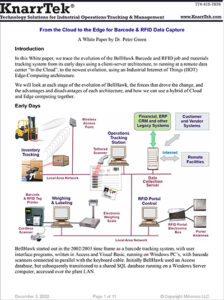 A second KnarrTek white paper, written by Peter and Eric Green—”Why Is the Inventory in My ERP System Always Wrong?“—is intended for chief financial officers, materials managers and other senior managers at manufacturing plants, as well as industrial distribution warehouses that perform secondary operations like repacking, kitting, assembly and product relabeling. A critical role of enterprise resource planning (ERP) systems for such managers is to track the quantity and value of inventory.
A second KnarrTek white paper, written by Peter and Eric Green—”Why Is the Inventory in My ERP System Always Wrong?“—is intended for chief financial officers, materials managers and other senior managers at manufacturing plants, as well as industrial distribution warehouses that perform secondary operations like repacking, kitting, assembly and product relabeling. A critical role of enterprise resource planning (ERP) systems for such managers is to track the quantity and value of inventory.
This is necessary for accurate balance-sheet reporting, KnarrTek explains, and it’s critical since it often forms the collateral for bank loans, and any changes in inventory value need to synch with the profit-and-loss statement. Accurate inventory counts are essential when forming the basis of ordering in response to pending customer orders, as well as deciding what to make and when. The authors examine case studies for which inaccurate inventory impacted operations, and they describe common problems and a possible solution. Both white papers can be downloaded from RFID Journal’s white paper library.


